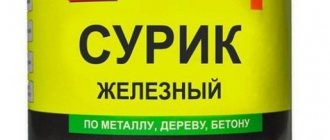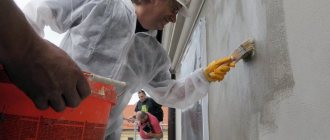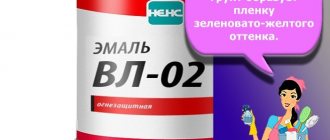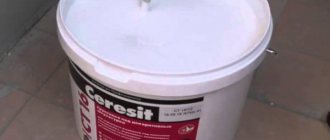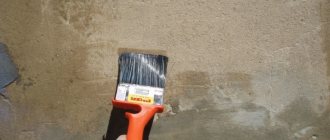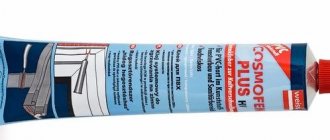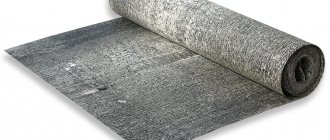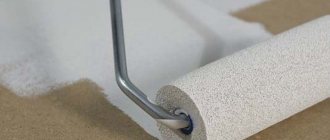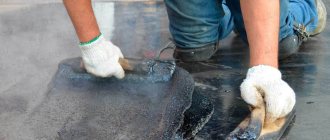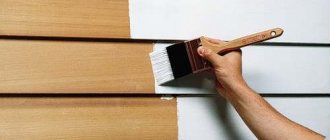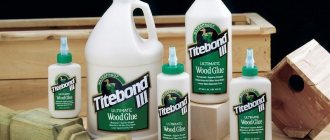An adhesion primer is a special mixture that prepares the surface for further application of finishing materials. There are quite a few varieties of products of this type, but not every soil may be suitable. Therefore, it is very important to choose a material that will significantly extend the service life of either concrete, metal, brick, or any other material.
Purpose and application
The term “adhesive primer” refers to soils that contain quartz sand and polymers. Sand imparts a certain degree of roughness to the entire mass so that construction mixtures in the form of putty and plaster (their base can be different: cement, acrylic, gypsum) adhere well to other finishing materials.
Main functions of the solution:
- protects metal from corrosion;
- does not allow moisture to penetrate building materials;
- protects against fungal infections and mold;
- increases the strength of cracked and porous surfaces.
IMPORTANT. You can often find another name in stores: “concrete contact”, which has high alkalinity.
Benjamin Moore or Tikkurila?
Benjamin Moore Primers
Suitable for processing wood, fiberboard, aluminum, plastic, glass, ceramics, brick, metal, concrete and so on. Such compositions are perfectly applied even on slippery surfaces, and after application a latex coating is formed that prevents the formation of bubbles.
Tikkurila primers
create an invisible layer for better adhesion and are suitable for any surface - wood, metal, drywall, concrete, plaster, brick. Thanks to the adhesive component, the mixture strengthens the loose material and forms a durable protective film on the surface. The antiseptics in the composition protect against fungus and mold, and the anti-corrosion agents protect the metal from moisture.
Composition and technical characteristics
The adhesion primer consists of the following components:
- quartz sand (sand fraction affects the thickness of the applied layer);
- polymer base (PVC, silicones and other substances);
- film-forming substances (glue, resin, oils, bitumen);
- drying accelerator;
- additional components, depending on what type of finish will be used in the future (they provide water-repellent, antibacterial, anti-corrosion qualities).
Thanks to adhesion, finishing materials adhere well to each other and do not peel off in the future and last a long time. However, some materials have a low degree of adhesion, so a primer is necessary. It is sold at any hardware store. When purchasing, it is worth considering what surface the adhesive mixture will be applied to in the future - rough or smooth. Based on these characteristics, manufacturers have developed a number of chemical effects.
For example, a solution for smooth surfaces must contain a large number of adhesive components. Greater roughness can be achieved by adding coarse sand to the solution.
Consumption per 1 m2
The adhesive mixture is quickly consumed if applied to a porous surface. However, if the finishing material is expensive, it is better to apply a larger layer of adhesive primer and save money in the future. The sand fraction in the base also affects consumption. The larger the fraction, the larger the layer that will be applied in the end. This is not entirely economical, so many people use the fine fraction.
To correctly calculate what proportions of the substance you need, you need to read the manufacturers' instructions. Primers that are applied in a thin layer are consumed in approximately 20 g/m2, this is the minimum value. Average values vary from 150 to 250 g/m2. If the composition is reapplied as a second layer, its consumption may increase to 525 g/m2.
Definition
- What material is called an adhesive primer??
In construction, it is customary to use this term for a very specific composition - polymer-based soil with the addition of quartz sand. It makes the surface rough, improving adhesion between it and a variety of building mixtures - plasters and putties (including decorative) on a cement, gypsum and acrylic basis.
Puttying with cement putty on concrete contact.
Another common name for this class of soils is concrete contact (concrete contact). I have a strong suspicion that this name comes not from the merger of the words “concrete” and “contact”, but from a distortion of the name of the Betokontakt primer from the German company Knauf, one of the first to enter the domestic market.
Adhesive soils can often be found under another name - “contact concrete”.
However
In practice, most primers, regardless of the label on the package, affect the adhesive properties of the surface. Let me give just a couple of examples:
- Adhesive primer for chrome plating of metal surfaces is applied as a base coating for chemical metallization of parts. The two-component composition, as the name suggests, promotes the adhesion of chromium particles to the surface when it is reduced from salts;
Adhesive primer for chemical chrome plating.
- Any deep penetration primer affects the adhesion of the base to the finish coat by strengthening it and adhering fine dust to the surface, preventing the surface from falling off.
Any acrylic primer improves the adhesive properties of the surface.
Plaster and putty are primed for painting and wallpaper precisely for the sake of maximum adhesion to the base of the finishing coating. An additional argument in favor of priming is the reduction in paint or wallpaper glue consumption.
Painting of walls is carried out after preliminary priming with penetrating primer.
Peculiarities
The primer is the link between the surface and the final finish. In order for this finish to adhere firmly to any surface (smooth, rough), it is necessary to apply a layer of thick mortar.
To easily apply putty, distribute paint evenly, and prevent moisture permeability from the inside, you cannot do without an adhesive agent.
Acrylic primer is popular today because it can be simply diluted with water.
Mineral soil allows you to apply a layer and reduce the roughness of brick, concrete, foam concrete structures.
Alkyd and glypthal mortar are needed for processing wooden products.
If you observe the following picture: the wallpaper is sagging, the decorative plaster is stained and cracked, the materials have peeled off, then this means that illiterate repairs were done without a soil foundation at all.
Smooth surfaces
Please note that a primer for concrete may differ significantly from a similar product for plastic. There is a large list of surfaces that do not have pores and are not highly absorbent. The primer presented above is not suitable for them.
Smooth surfaces include plastic, glass, metal, paint and other similar materials. It is for them that compositions called primers are used. They are characterized by high adhesive ability. Such compositions make the surface rough. In this case, the finish can be firmly fixed to the base.
One of the most popular materials used in this case is “Betonkontakt”. It is manufactured by many large companies. The composition of such primers differs significantly from products intended for rough surfaces.
Advantages and disadvantages
Adhesive primer has a number of advantages over other finishing materials:
- The coating adheres well, as a result of which paints, enamels and plaster adhere well.
- Affordable price.
- When used correctly, it saves money and reduces soil consumption.
- You can dilute the thick mixture with thinner or water (if it is made with an aqueous solution).
- The mixture dries quickly (3 – 4 hours).
Despite the positive characteristics, there are a small number of disadvantages:
- If applied incorrectly, the solution crumbles and in the future it is necessary to waste money and time again and start repairs all over again.
- Do not mix solutions with each other.
- If you apply the mixture to a contaminated area, it will soon collapse.
Do I need to prime the walls and how?
Nowadays, when many building materials have appeared on the market, many have doubts about the advisability of using some of them. In this article I will express my opinion on whether it is necessary to prime the walls and tell you how to do it correctly.
During the Soviet Union, when there were no primers yet, everyone did repairs without it. Everything worked out great and held up. So many people wonder whether surfaces need to be primed. It’s just that before there were different technologies, and therefore different materials. Modern repair technologies require priming.
Whether it's painting a car or a wooden door. When renovating an apartment, primer is also necessary, but not always.
To understand when and what surfaces need to be primed, let’s look at the characteristics of the primer. This material bonds mineral surfaces. That is, this is an ideal option for processing old plaster that is crumbling. The primer also creates a film on the surface of the materials, which ensures uniform porosity of the materials. This means it will be much easier and of better quality to putty and paint on primed surfaces. And another quality of the primer is that it increases adhesion between materials. This means that wallpaper or ceramic tiles will stick to the wall better.
But there are times when surfaces do not really need a primer. For example, drywall before putty. The drywall is already strong and clean. The only role of the primer is to remove dust that has formed after sanding the joints. In this case, the primer is diluted to a low concentration, 1 to 4 is quite enough. Or only the joints are primed, and the sheets themselves are wiped with a damp sponge.
Floors are also primed with diluted soil before laying laminate or linoleum. If the screed is strong and does not wear off from walking, then you just need to remove the dust. The screed is swept out and then primed. After priming, all dust disappears completely. Then you need to sweep the floor again to remove any remaining grains of sand.
Some surfaces cannot be primed at all. For example, brick walls before plastering. When I first started working in the renovation industry, I primed a white brick wall. As a result, a film formed on it, in addition to the fact that the material is already low-porosity. As a result, the plaster floated all the time, even if a thin layer was applied.
We conclude whether walls and other surfaces need to be primed? Before painting, puttying (except for drywall), wallpapering and laying tiles, this is a must. Before laying floor coverings and plastering, use diluted primer or do not prime at all.
Let's move on to the next question: how to prime the walls. It's very simple. Apply the primer evenly with a roller to the surface of the wall or ceiling. You can pour the soil onto the floor in small portions and roll it out with a roller.
It is the hardest to prime putty surfaces. If acrylic putty is applied in a thin layer, then with a heavy primer it can blur. Do not roll the roller in one place for too long. The roller should be short-haired. You cannot prime with a brush before painting. She will leave smears. Also, all drips and drops from the walls need to be removed, as they create grooves and then the drops dry out.
I hope I answered your question about whether walls need to be primed. Write your opinion on the above in the comments.
If you don’t understand something, go to the page: ask a question about repairs
Differences in primer by type of composition
In order to properly treat the area where the adhesive primer will be applied, you need to know what materials are needed for the work and what protective primer to choose. Today there are several options in stores:
- Alkyd. Thanks to the organic solvents that are part of the mixture, the solution fits well on any surface.
- Perchlorovinyl. Can be used in premises of any purpose. It is important to take into account the fact that the substances that are included in the composition are extremely dangerous to human life and health, so it is best to use the solution for outdoor work.
- Acrylic. It does not emit an unpleasant odor, the chemical composition is absolutely safe, therefore it is used for both internal and external finishing works. Hardens quickly and applies evenly. The composition contains the following components: acrylic resins and additional additives.
- Glyphthalic. Enhances the color of paints and varnishes thanks to the coloring pigments that are part of the mixture. Antiseptic and anti-corrosion properties protect objects to which the primer is applied. Wood, metal, and brick coatings can be processed.
Recommendations from experts
Experienced builders recommend carefully choosing an adhesive primer. It is important to take into account the characteristics of the surface being treated, subsequent finishing materials, as well as environmental conditions.
It is not recommended to apply the product to the surface at low temperatures. Processing is carried out at an average level of humidity. The ambient temperature must be +5ºC or higher. Otherwise, the quality of the composition deteriorates significantly.
It is necessary to purchase products for surface treatment only in specialized stores. You should not purchase cheap, little-known compounds. They are not able to provide the required adhesion strength of different materials.
Having considered what an adhesive primer is, its features and varieties, you can choose the best option that meets the conditions of finishing work.
Primer differences by area of application
Manufacturers of adhesive mixtures offer consumers a wide range of their products, which differ in technical characteristics and narrow scope of application.
Primer for treating porous surfaces
With the help of concrete contact, the surface is protected from negative environmental factors and becomes much stronger. In addition, another positive point is the ability to cover small cracks in concrete screeds. If the adhesive primer is applied correctly, it is quite possible for construction dust to stick together, as well as for maximum and high-quality bonding between layers.
Adhesive mixtures and paint coatings are consumed significantly less thanks to the primer layer, which forms a thin and durable film on the material and does not allow moisture and other negative factors to affect the object.
Quartz sand, which is part of the concrete contact, forms a roughness after application; adhesion properties are significantly increased. To make the layer even stronger, the mixture must be applied repeatedly.
The drying time of the mixture is 2-3 hours at a temperature of 15 degrees. Different colors allow you to see all previously restored places (for example, if the ceilings and ground were white, then the restored places simply would not be visible). Concrete contact is applied with a spray gun, roller, or brush. An aqueous solution, one of the components of the concrete contact composition, allows the substance to be used for both external and internal use. If you want to seal the first coat, wait until it is completely dry before applying the second coat.
Primer for working with low-porosity and smooth surfaces
The adhesive solution is used for puttying smooth glass, metal, paint and plastic surfaces. Also, if you need to plaster a place where there is a layer of paint, use a primer, which greatly facilitates the work and saves time. For example, after being applied to a paint coating, the solution lies evenly and covers possible cracks and small irregularities on the wall, and also adheres firmly to the paint and does not slip or crack in the future.
When developing adhesion, special components are added to the substance to prevent corrosion.
The metal does not rust for a long time, so almost all production and warehouse premises, as well as welded iron floors, are treated with this solution.
With the help of adhesive, you can fight premature destruction, corrosion and mold of a wide variety of materials. The multifunctional product can be applied to
different types of surface, including smooth. This is a significant plus, because it is very difficult to find a lubricant with a high degree of adhesion for a smooth façade finish.
Concrete contact
These days, adhesive concrete contact primer is very popular. This mixture is used for priming indoors and outdoors. When treating external or internal surfaces with this adhesive primer, an almost identical result is achieved as when priming with other acrylic products. Moreover, the adhesive characteristics of the primed base increase many times; an increase in adhesion becomes possible thanks to the needle-shaped quartz contained in the composition. When the primer dries, the treated base becomes rough, similar to sandpaper. Concrete contact has the following advantages:
- the operational life of this primer is at least 80 years, such a guarantee is given by the manufacturer of the mixture, which has a confirming quality certificate;
- The primed surface dries very quickly. After application, the composition, for example, otex adhesive primer, after a couple of hours can already be coated with a finishing finish;
- versatility of use. This adhesive primer is used for all types of surfaces during external and internal finishing work;
- resistance to penetration of water and moisture. After application, the composition creates a waterproof layer that lasts for a long time. This film protects the base from moisture and water; this primer is used if it is necessary to make, for example, a plastered wall completely waterproof for some time;
- there is no need to remove old finishing materials. The characteristics of the adhesive concrete contact primer allow it to be applied to an old layer of paint and varnish materials or tiles, this significantly saves the effort and time that would be required for dismantling work;
- The primer is resistant to the growth of fungi and mold.
Concrete contact is sold in the form of a one-component composition and a two-component solution. Beginners in the field of finishing work usually purchase a ready-to-use primer, while experts prefer two-component adhesive products.
Tips and recommendations for use
IMPORTANT. To ensure that the mixture does not crack or peel in the future, it must be applied correctly.
Manufacturers provide customers with instructions for using their products. Therefore, before carrying out repair work, you should familiarize yourself with the basic rules of this activity.
For example, in order to treat a wall, you must first remove grease, dirt, dust, possible other contaminants, and remnants of previous finishing materials from it. Some surfaces are washed and dried if necessary. A brush or roller are ideal tools. Professional installation organizations often use a method where the composition is sprayed through a spray gun or spray gun under high pressure. This allows you to save money.
In addition, it does not take much time to dry - the product is applied in a thin layer and distributed evenly. Some people re-spray the soil to strengthen the first layer. In addition, in order to save money, as a rule, a budget option is chosen as the first primer, and concrete contact is placed as the second layer - a more expensive means.
When the composition dries, white or pink films form on the wall, depending on the color of the composition. If the primer is applied to an untreated surface, you should not expect a miracle - unfilled holes in the wall will become even more noticeable.
If you bought primer and see that its concentration is quite thick, you need to purchase a solvent and dilute the adhesive solution. If the composition is made from a water base, it is generally diluted with ordinary water. However, it is worth considering that when mixing different adhesive primers, you will not achieve a positive result simply due to the fact that each mixture is made from different, quite possibly practically incompatible, components.
All tools used in the repair process are washed well with water immediately after use.
Self-cooking
- Is it possible to prepare an analogue of an adhesive primer yourself??
The price of Betokontakt is more than 3,000 rubles for a 20-kilogram package, which does not fit well into the modest budget of a small repair, so the question is quite reasonable.
The easiest way to obtain soil is to mix sodium or potassium liquid glass with sifted sand. The mixture is prepared in small portions (no more than 1 liter) and applied to the base with a brush, which is thoroughly washed with water immediately after use.
The photo shows liquid glass, also known as silicate glue.
Review of popular manufacturers
The following product brands are popular today:
- “Master primer No. 1” Used as a facing material for both internal and external work. It is notable for the fact that when you open the can, you can immediately start working. Helps combat increased moisture permeability. For greater effect, it is recommended to carry out repair work at temperatures above 5 degrees Celsius. Permissible air humidity is about 55%. If the humidity is higher, the primer will take longer to dry. If the substance gets on your skin or eyes, you should immediately rinse the affected areas with running water.
- “Ground-contact” Technical characteristics are very similar to “Master-ground No. 1”. The difference lies in the type of surface - “Ground Contact” can be applied for finishing walls, foundations, and also for preserving facades for the winter.
"Betonkontakt"
When choosing a primer for concrete and other smooth surfaces, you should give preference to a variety such as “Betonkontakt”. The product presented was first produced in Germany. It was first introduced to the market. Subsequently, other world brands began to produce the presented composition.
This is a universal product that can significantly improve the adhesion of the finish to the surface. It is used not only for concrete, but also glass, metal, tiles and even painted surfaces.
If the base has a low ability to absorb moisture, preference should be given to “Betonkontakt”. Today, in addition to Knauf primers, compositions and Prospectors are very popular of this type. Their prices vary significantly. It can range, depending on the manufacturer, from 200 to 500 rubles. for 1 l.
What should be the soil in the bathroom and toilet?
These rooms are areas of high humidity.
Accordingly, the moisture resistance of the walls here needs to be treated with increased attention. The primer requirements here are very strict.
She must be:
- antifungal - mold often accompanies such premises;
- not only moisture-resistant, but water-repellent;
- have the ability to increase the adhesion of the wall and paintwork or tile materials in conditions of contact with both cold and hot water.
The last point applies to the bathroom or combined bathroom.
It is logical to assume that the floor of such premises should also be waterproofed, but according to building codes approved back in 1988, bathrooms are considered low-intensity rooms; there is simply no exposure to liquids and similar mixtures. If you want to be on the safe side, apply a water-repellent primer yourself during the repair.
Waterproofing primer for concrete
Externally, concrete is a durable material, but it has high porosity. In this regard, its absorbency is relatively high, which contributes to the destruction of the material with frequent loss of moisture. In addition, when applying paint to a concrete surface, its consumption increases significantly.
Therefore, applying a primer here becomes a necessity. Typically, concrete is coated with deep penetration mixtures.
When choosing them, you should be guided by the following criteria:
- if the surface is made using concrete grades M 150 or M 300, select an epoxy or polyurethane primer;
- if finishing work is planned to be carried out at sub-zero temperatures, you can also use normal penetration soil;
- operating conditions and surface load should be taken into account;
- Often rooms with a concrete floor are industrial, here vibration load, impact and other similar factors should be taken into account.
Waterproofing primer for concrete
Hydrophobic primer for walls
The walls, of course, do not bear the same load as the floor, but primer is recommended here too for the following reasons:
- the surface is smooth and even;
- the strength of the wall increases;
- paint is applied much easier;
- Wallpaper is glued onto such a treated surface more smoothly, and it peels off less;
- In this way, certain design defects can be hidden.
Waterproof floor primer
The main task of such a mixture is to increase the adhesion of materials so that the floor covering lies flat on the base and is firmly attached. Mixtures in these cases are selected differentially.
For example, in a bathroom it is best to use deep-penetrating materials, in a children’s room - a mixture with an antiseptic effect, and it is more rational to cover the floors of an unheated dacha with an antifungal composition.
Water-repellent primer for wallpaper
There are no perfectly straight walls. You start to notice this when you start gluing wallpaper. To make the process more productive, it is recommended to apply a primer first. You can choose different types:
acrylic mixtures are reliable, environmentally friendly, applied to all surfaces except iron, due to the risk of rust development; alkyd is well suited for wooden walls, but contact with plaster does not matter; glyphthalic - just right for metal walls; vinyl is best suited for liquid wallpaper
Water-repellent primer for wallpaper
Types of acrylic primer
Depending on your tasks, you can choose one of two main types of acrylic primer:
- Strengthening – it contains binding elements 10 times larger in size than the deep one. This allows the strengthening mixture, which is produced today in accordance with GOST, to bond the surface well. It is not a deep penetration soil.
- Deep - has excellent technical characteristics, high penetrating properties, as well as the ability to saturate and strengthen the base to a depth of about 10 cm. This may be required when the walls in the home are created using low-quality cement, which contains too much sand. This type of surface usually begins to crumble and requires strengthening. The price of a deep penetration primer may be higher than a strengthening primer, so it is worth considering the need to use it.
When choosing soil, you should pay attention to the solid substance included in the composition. Its content in the deep penetration agent should not be less than 10%, which is indicated in the product passport and meets the requirements of GOST
This will imply that there is little acrylic dispersion in the composition.
Even before purchasing, you should make sure that the material is transparent - the color of the primer should be somewhat cloudy and white, similar to milk. A test for the type of primer is easy to do. If you apply it with a brush to the surface, the strengthening agent will become a film when it dries, and the deep-penetrating acrylic primer will leave almost no traces.
In addition to the two main types, there are also subspecies, depending on the purpose.
Deep soil for plasterboard is suitable for moisture-absorbing surfaces (gypsum boards, foam concrete, brick, and cement). Used before laying tiles in the bathroom, applying paint to the wall or wallpapering. Suitable for interior and exterior work. Able to dry from 40 minutes to 6 hours. According to GOST, this mixture does not contain solvents; it guarantees good adhesion to any type of surface. It is diluted with warm water, is environmentally friendly, and has no specific odor. Consumption – 1 liter of product per 10 square meters of area. This is true when applying one layer.
An adhesive primer mixture is produced for surfaces that do not tend to absorb moisture (monolithic slabs, blocks, ceilings). Used before coating with plaster, gypsum, limestone-gypsum compositions. The surface after such primer becomes rough, which contributes to excellent joining with the finishing material. This product is made according to a German recipe and is environmentally friendly. Consumption – 1 liter per 5 square meters.
Wood primer is a white liquid of uniform consistency, which contains one component. Designed for interior work, perfect for finishing painting of furniture and doors. Creates a durable layer with high adhesive characteristics. After drying such a mixture, which meets the requirements of GOST, the surface can actually be sanded and the defects neutralized. When using water-based primer on wood, you can really save on finishing paint. When wood, which already absorbs moisture well, is saturated with primer, the main paint remains on the surface. Consumption – 1 liter per 10 square meters. But a lot depends on the type of surface.
Latex primer for interior work is suitable for absorbent or unevenly absorbent surfaces. It will serve to strengthen mineral bases and is necessary for leveling plasterboard sheets and plasters.
Facade is a mixture of acrylic and latex; it can be used for outdoor work in low temperatures and before subsequent painting. Suitable for new or previously painted wood, fibreboard siding, aluminium, galvanized metal, masonry, plaster, concrete. Dries after 2 hours, can be reapplied after 3 hours. It has a rich color palette that includes 14,000 shades.
And this is not all the types of primer that manufacturers produce based on acrylic.
